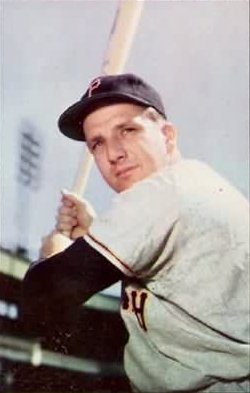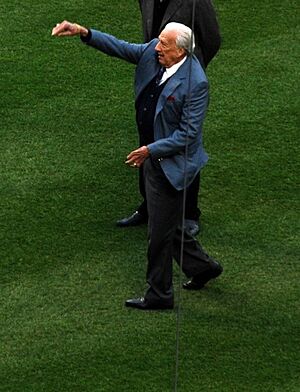Ralph Kiner facts for kids
Quick facts for kids Ralph Kiner |
|||
|---|---|---|---|

Kiner c. 1953
|
|||
| Left fielder | |||
| Born: October 27, 1922 Santa Rita, New Mexico, U.S. |
|||
| Died: February 6, 2014 (aged 91) Rancho Mirage, California, U.S. |
|||
|
|||
| debut | |||
| April 12, 1946, for the Pittsburgh Pirates | |||
| Last appearance | |||
| September 25, 1955, for the Cleveland Indians | |||
| MLB statistics | |||
| Batting average | .279 | ||
| Home runs | 369 | ||
| Runs batted in | 1,015 | ||
| Teams | |||
|
|||
| Career highlights and awards | |||
|
|||
| Induction | 1975 | ||
| Vote | 75.41% (13th ballot) | ||
Ralph McPherran Kiner (October 27, 1922 – February 6, 2014) was a famous American Major League Baseball player and later a popular broadcaster. He played as an outfielder for teams like the Pittsburgh Pirates, Chicago Cubs, and Cleveland Indians from 1946 to 1955. After he stopped playing, Kiner became a well-known announcer for the New York Mets, starting when the team was new and continuing until he passed away.
Even though injuries made him retire after only 10 seasons, Ralph Kiner was amazing at hitting home runs. He hit more home runs than anyone else in the National League between 1946 and 1952. Because of his incredible career, he was chosen to be in the Baseball Hall of Fame in 1975.
Contents
Early Life and Military Service
Where Ralph Kiner Grew Up
Ralph Kiner was born in Santa Rita, New Mexico. He spent most of his childhood growing up in Alhambra, California.
Ralph Kiner's Service in World War II
Before he became a baseball star, Ralph Kiner served his country. He was a United States Navy pilot during World War II. Kiner joined the Navy in 1943. He became a pilot in December 1944. He flew large planes called PBM Mariner flying boats. These planes were used to patrol for submarines near Hawaii.
Ralph Kiner's Baseball Career (1946–1955)
Starting with the Pittsburgh Pirates
Ralph Kiner began his professional baseball career on April 12, 1946. His first team was the Pittsburgh Pirates. In his first season, he hit 23 home runs. After that season, a famous player named Hank Greenberg helped Kiner improve his hitting.
Becoming a Home Run King
In 1947, Kiner became a true home run leader. He hit 51 home runs, which was the most in all of Major League Baseball that year! Many of his home runs at the Pirates' home field, Forbes Field, landed in a special short section of the outfield. This area was even nicknamed "Kiner's Korner" because of his powerful hitting.
In 1949, Kiner hit an amazing 54 home runs. This was the highest number of home runs hit in the major leagues for many years. It also made him the first player in the National League to have two seasons with more than 50 home runs. From 1947 to 1951, Kiner hit over 40 home runs and had over 100 RBIs (runs batted in) every single season.
Kiner led the league in home runs for seven years in a row, ending in 1952. He was also chosen to play in the Major League Baseball All-Star Game for six straight seasons, from 1948 to 1953.
Moving to Other Teams
On June 4, 1953, Kiner was traded to the Chicago Cubs. This happened because of disagreements about his salary with the Pirates' general manager. Kiner played for the Cubs for the rest of 1953 and all of 1954. He finished his playing career with the Cleveland Indians in 1955.
Retirement from Playing
A back injury forced Ralph Kiner to retire from playing baseball when he was only 32 years old. He ended his career with 369 home runs and 1,015 RBIs. His lifetime batting average was .279. He hit over .300 three times in his career, with his best being .313 in 1947.
Broadcasting Career (1961–2013)
 |
|
| Ralph Kiner was honored alongside the retired numbers of the New York Mets in 2014. |

After his playing days, Ralph Kiner became a baseball announcer. In 1962, he joined the new New York Mets team as one of their first broadcasters. He also hosted a popular post-game TV show called "Kiner's Korner." He even helped announce the Mets' games in the 1969 World Series and 1973 World Series for national radio. Kiner won an award for his excellent broadcasting work.
Kiner was known for his unique way of speaking, sometimes mixing up names in a funny way. For example, he once called himself "Ralph Korner." Even after he had a health issue called Bell's palsy, which affected his speech, he continued to broadcast for 53 seasons! His famous home run call, "It is gone, goodbye," became a signature phrase in baseball.
As he got older and his health declined, Kiner appeared less often on Mets broadcasts. However, when he did, the other announcers would always welcome him. He would share stories from baseball's past and talk about the current game. In his last season in 2013, he was the oldest active announcer in Major League Baseball.
Ralph Kiner's Personal Life
Ralph Kiner was often seen with famous celebrities like Elizabeth Taylor and Ava Gardner. This was partly because the famous singer Bing Crosby was a part-owner of the Pirates team. Kiner was married four times. His first wife was tennis star Nancy Chaffee.
Ralph Kiner's Legacy
 |
|
| Ralph Kiner's number 4 was retired by the Pittsburgh Pirates in 1987. |
Ralph Kiner was inducted into the Baseball Hall of Fame in 1975. This was a very close vote, and he was the only player elected that year. He attended every Hall of Fame ceremony until he passed away.
In 1984, Kiner was also elected to the New York Mets Hall of Fame. The Pittsburgh Pirates honored him by retiring his uniform number 4 on September 19, 1987. This means no other Pirates player will ever wear that number.
In 1999, The Sporting News ranked him among the "100 Greatest Baseball Players." The Mets also honored him with a special "Ralph Kiner Night" in 2007. They later named the home broadcast booth at their new stadium, Citi Field, after him. In 2014, the Mets "retired" Kiner's broadcast microphone. They added a special logo with his name and a microphone to the left-field wall at Citi Field to remember his long and important career with the team.
Death
Ralph Kiner passed away peacefully on February 6, 2014, in Rancho Mirage, California. He was 91 years old. The owner of the New York Mets, Fred Wilpon, said that Kiner was "one of the most beloved people in Mets history." At the time of his death, Kiner had been dealing with Bell's palsy and the effects of a stroke he had suffered earlier.
After his death, fans started an online petition to rename sections of Citi Field as 'Kiner's Korner' to honor his 52 years with the Mets.
See also
 In Spanish: Ralph Kiner para niños
In Spanish: Ralph Kiner para niños
- 50 home run club
- List of Major League Baseball career home run leaders
- List of Major League Baseball career runs batted in leaders
- List of Major League Baseball annual home run leaders
- List of Major League Baseball annual runs batted in leaders

